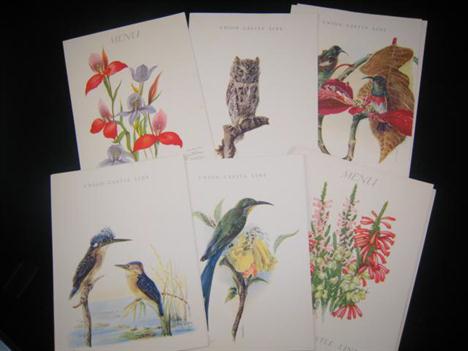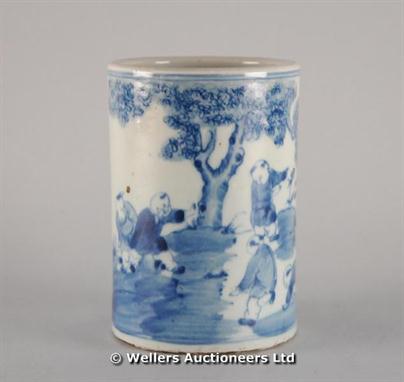A PAIR OF CROWN DERBY FIGURES OF A BOY AND GIRL PLAYING BLIND MAN`S BLUFF probably modelled by William Stephan, in a two tone blue spotted dress or coat and yellow striped skirt or brown breeches, on oval gilt base, 18cm h, printed mark, c1878-80 ++Boy - hands restored. Girl - hairline crack in left wrist and flat chip on side of base
We found 79738 price guide item(s) matching your search
There are 79738 lots that match your search criteria. Subscribe now to get instant access to the full price guide service.
Click here to subscribe- List
- Grid
-
79738 item(s)/page
Scarce 1952/53 West Bromwich Albion signed ball team picture– special Gazette newspaper photograph to include the entire playing squad and “the men behind The Hawthorns scene” – neatly signed in pen, players include 10x from the 1954 F A Cup winning team to incl Ronnie Allen, Sanders, Dugdale, Dudley, Barlow, Griffin, Ryan, Nicholls, Millard, Lee plus legend W.G. Richardson, Heath, Williams, Hewson, Charlesworth, Hilton, et al (35) mf&g overall 12” x 15”. Note: It is understood that there was no official team photograph between 1952/53 hence a rare find.
A tall waisted Chinese Transitional vase, Chongzhen period, 1628-1644Painted with the “Hehe erxian”, one brother playing the flute, the other playing with a toad, an incised band around the mouth, flat unglazed base24.8cm high, 11.8cm diameterProvenance: The Collection of Colin Lanceley, Sydney.
A VICTORIAN ROYAL WORCESTER PORCELAIN ORNAMENT fashioned with a boy playing pipes to a girl who`s holding an urn, in green and brown colouring with naturalistic base, Date Code, 1886, 17.5cm high, together with an 1850`s KERR & BINS WORCESTER ORNAMEN T of an amorini and urn, with similar colouring, 12.5cm high
An engraved brass mounted ebonised small mantel clock now incorporating a musical box mechanism. Unsigned, probably Austrian, mid 19th century and later. The two train bell striking movement with push-button hour repeat, standing barrels, anchor escapement and shaped plates, the white enamel Roman numeral waisted dial with elaborate scroll hands and overlaid with a pierced and engraved brass decoration to the lower section, in a waisted ebonised case with button finial and ogee moulded surmount above rectangular side windows, the front and side surfaces overlaid with conforming shaped pierced and engraved lacquered brass decoration, on two later gilt brass rail supports, 24cm (9.5ins) high; with original conforming ebonised plinth applied with further decorative brass mounts and now fitted to upper surface with a later musical box mechanism formerly playing a choice of two airs via a 2.25 inch cylinder and tuned steel comb within brass frame and glazed cover, on scroll cast brass feet, (musical mechanism incomplete, dial with faults) 18.5cm (11.25ins) high overall.
A Fine George III Scottish military commemorative ebonised musical bracket clock Turnbull and Aitchison, Edinburgh, circa 1778. The substantial six pillar triple fusee movement with verge escapement, striking the hour on a bell before playing a lively tune on eight bells with fifteen hammers every hour, the foliate scroll engraved backplate with oval reserve signed Turnbull & Aitchison, Edinburgh within a leafy border with eagle surmount, the 8 inch black velvet covered break-arch dial with blued steel ring-turned collets to the winding holes and separately applied silvered Roman numerals with Arabic five minutes and dot minute markers between, the arch applied with shaped plaque inscribed in raised silvered lettering COL. BIRD 15 REG. HOBL. WILLM. FALCONER LT. GRENAD. KILLD. action of Brandywine SEPT. 11 1777 around a memento-mori motif on a black background, the bell top case with five pineapple finials above caddy moulded angles and brass handle over circular and concave-topped rectangular foliate pierced frets to sides, on moulded base with cast brass paw feet, 52cm (20.5ins) high. Provenance: The property of a private collector. Possibly commissioned by Anthony Adrian Keith-Falconer the 7th Lord Halkerton, 5th Earl of Kintore for his newly acquired seat, Keith Hall, circa 1778. Thence down the family line to Arthur George Keith-Falconer 12th Lord Halkerton, 10th Earl of Kintore before possibly passing to his widow Helena Zimmerman, (previously Duchess of Manchester) on his death in 1966. Thence by family descent until sold at Sotheby`s, London, January 21st 1995 (with provenance as property of the Dowager Countess of Manchester thence by descent). Subsequently at Hayfield House, Saratoga, California prior to acquisition by the current owner. The clockmaking partnership of Turnbull and Aitchison (probably William and Robert) is recorded in Baillie, G.H. Watchmakers & Clockmakers of the World as being active 1768-80. The current lot commemorates the loss of the 4th Earl of Kintore`s youngest son, Willem, at the Battle of Brandywine in 1777. The clock also commemorates the death of his commanding officer Lieutenant Colonel John Bird who was killed at the subsequent action of Germantown. The battle at Brandywine Creek was the first significant action between the British and American forces during Sir William Howe`s Philadelphia campaign of 1777. In late July Howe had landed his force of around 17,000 troops at the Northern end of Chesapeake Bay with the intention of marching on Philadelphia. The American force of 20,600 troops under the command of General George Washington positioned themselves near the strategic crossing of Brandywine Creek at Chadd`s Ford with further divisions covering other crossing points nearby. Lord Howe, (relying on better intelligence provided by sympathetic locals) decided to commit to an outflanking manoeuvre. As a diversion, around 5,000 troops, mainly Hessian Guards under the command of Lieutenant General Wilhelm von Knymphausen, were deployed to confront Washington`s forces at Chadd`s Ford. The rest of Howe`s forces, under the command of Major General Lord Charles Cornwallis, headed north, intending to cross Brandywine Creek at Trimble`s Ford before attacking the rear of Washington`s right flank. After crossing, Howe allowed his troops a two-hour rest from their exhausting 17 mile march (to take afternoon tea according to American accounts) before advancing on to outflank the American forces. Howe`s hesitation allowed the Americans enough time to consolidate some of their troops on higher ground at Birmingham Meeting House which subsequently slowed Howe`s advance enough to allow many of the enemy troops to withdraw safely. Meanwhile Knyphausen, on the east bank of the Brandywine at Chadd`s Ford advanced into the weakened American centre forcing their retreat. Careful damage limitation, co-ordinated by Gilburt du Motier, Marquis de Lafayette, ensured that the battle was not turned into a rout of the American forces who managed to retreat and regroup at Chester. The victory at Brandywine allowed the British and Hessian forces to take Philadelphia with little resistance on 26th September 1777. At Brandywine 15th Foot were attached to Lord Cornwallis`s column and were under the command of Major General Charles Grey. Grey`s troops were engaged in perhaps the bloodiest part of the battle attacking General Sullivan`s position at Birmingham Meeting House. The 15th Foot were short of musket balls hence only the sharpest of shooters was allowed to fire `live` at the battle with other troops firing small charges of powder only, this lead to the regiment being nicknamed `The Snappers` It is probable that Lieutenant Grenadier Willem Falconer was attached to this force hence probably lost his life near the Birmingham Meeting House. Colonel John Bird survived Brandywine but was possibly wounded as he is recorded as `lying sick` at Bringhurst House, Germantown when the American forces attacked on 4th October. He apparently arose from his bed to lead his troops but was subsequently mortally wounded and died after the battle at Bringhurst House. He is buried at DeBonneville cemetery, Philadelphia in a grave with the inscription; Here lie the remains of General James Tanner Agnew a British Officer who was killed at Germantown on the 4th October 1777 and of Lieutenant Colonel John Bird a British Officer at Germantown on or about the 4th October 1777. The bodies of the above were removed from the lower Burial Ground Germantown by order of General Howe and placed in this cemetery with the consent of Doctor George de Benneville in May 1778. Requiescat in Pace. This stone was erected in their memory by His Britannic Majesty`s Government, October 4th 1903. The fact that the current lot commemorates both the death of Lieutenant Falconer as well as his commanding officer, Colonel John Bird, is unusual. The Keith-Falconer family perhaps chose to include his name on such a personal object of remembrance as a mark of respect for his heroism and influence on their son.
An unusual padouk wood musical alarm table clock. Berguer London, probably early 19th century, The five pillar twin chain fusee movement with verge escapement and alarm playing a choice of two peels or a lively melodic tune on eight bells, the backplate engraved with an urn within a rococo scroll cartouche and decorative border incorporating leafy sprays to angles, the 7 inch brass break-arch dial with alarm disc to the matted centre and blued steel hands within an applied silvered Roman numeral chapter ring with stylised fleur-de-lys half hour markers and Arabic five minutes to outer track and signed Berguer, London to lower edge the angles with female mask and scroll pattern spandrels beneath arch with CHIME/SILENT dial flanked by conforming scroll cast mounts, in a case with brass carrying handle to a moulded panel following the profile of the break-arch top with brass pineapple finials, the front door with ebonised fillet mouldings to the glazed aperture and brass inset angles, the sides with circular foliate scroll engraved brass sound frets above concave-topped windows, on moulded base with brass bracket feet, 39.5cm (15.5ins) high. Four makers with the surname Berguer (probably brothers) are recorded in Baillie, G.H. Watchmakers & Clockmakers of the World as working in London during the first quarter of the 19th century; Frederick 1805-24, John 1809-24, Francis (Holborn) 1820 and Joseph 1820. Two generations of makers with the same surname are also recorded working in Chaux-de-Fonds, Switzerland during the 18th century hence it is probable that the London based makers at the start of the 19th century were first generation immigrants. The fact that the maker of the current lot was probably an immigrant may account for the unusual specification of the movement (which plays music as an alarm only) as well as the individual nature of the detail design of the case. These variations perhaps echo those seen on clocks made in London by an earlier generation of Huguenot immigrant makers working during the early years of the 18th century.
A MAHOGANY CARD TABLE, SECOND HALF 19TH CENTURY the hinged circular top with an inset baize playing surface concealing a pair of compartments above a gate-leg, on turned supports and carved outswept legs joined by a shaped and carved stretcher, marked patent Feb. 18 1873 77,5cm high, 70,5cm diameter 1
A GERMAN EBONISED BRACKET CLOCK, CIRCA 1880 14cm brass dial with a silvered chapter ring, Roman numerals, date aperture and an aperture with a mini pendulum, three subsidiary dials in the arch, an on-and-off alarm, alarm and a moon dial, the clock striking and playing a tune on six bells, the stepped hood surmounted by a brass finial, the panelled door on a stepped plinth base, on brass bun feet, paper label indicating sold in Dresden by Aug. Friedemeyer Königsbruecke Strasse 69, signed Zacharias Conrath, A. Breslau on the backplate, distress, restorations 42cm high 1
-
79738 item(s)/page






















































